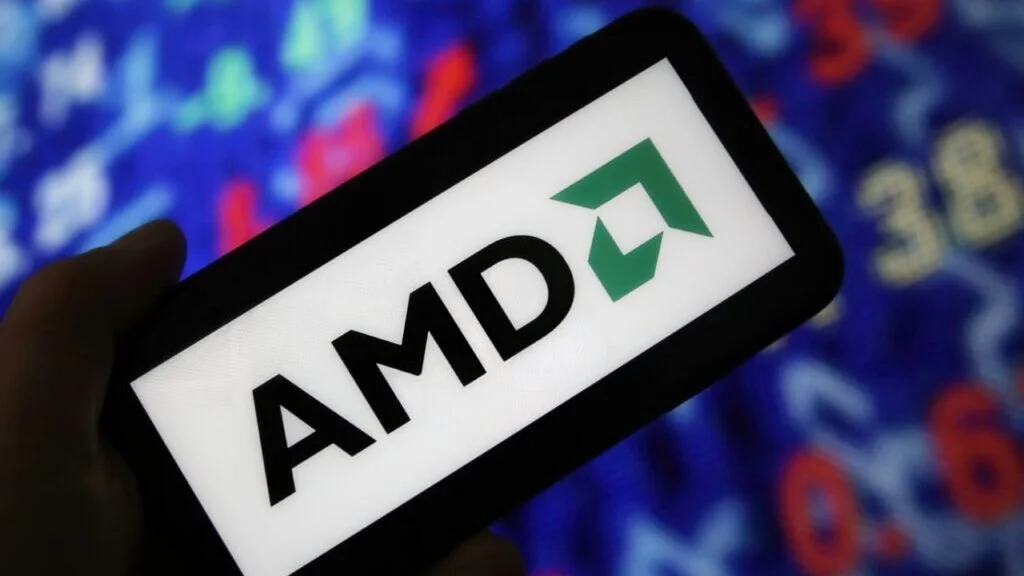Introduction
Advanced Micro Devices (AMD) is a leading semiconductor company known for its high-performance processors and GPUs.
As a key player in the tech industry, AMD stock is widely traded by investors and traders alike. In this guide, we’ll explore how to trade AMD stock, analyse its market trends, and understand the risks involved.

Why invest in Advanced Micro Devices stocks
AMD is a major player in the semiconductor industry, competing with giants like Intel and Nvidia. Its innovation in accelerated processing units (APUs), gaming GPUs, and data centre solutions has driven strong stock price movements. Here’s why AMD stock is an attractive investment.
What is Advanced Micro Devices Inc. and why is it a market leader?
Founded in 1969, AMD has evolved into a powerhouse in the semiconductor industry, consistently pushing the boundaries of high-performance computing solutions. From desktop processors to enterprise-grade server chips, AMD has cemented its reputation as a key innovator, directly competing with industry giants like Intel and Nvidia.
Its market leadership is driven by advancements in processors, graphics technology, and data center solutions. The launch of Ryzen processors and Radeon GPUs has transformed the consumer and gaming markets, while AMD’s EPYC server processors have gained significant traction in cloud computing and AI applications. AMD’s ability to balance innovation with affordability has helped expand its market share across multiple sectors, making it a compelling choice for investors seeking exposure to cutting-edge technology.
Advanced Micro Devices stock price history and key milestones
AMD’s stock has experienced significant price fluctuations, influenced by technological advancements, competition, and macroeconomic trends.
Key milestones include the launch of Ryzen processors, data centre growth, and stock splits that impacted valuation and investor sentiment.
What affects the price of Advanced Micro Devices shares?
AMD’s stock price is influenced by multiple factors, including:
- Earnings reports: Strong financial performance drives stock price growth.
- Competition: Rivalry with Intel and Nvidia affects market share and valuation.
- Macroeconomic factors: Inflation, interest rates, and global crises impact investor sentiment.
How to invest in Advanced Micro Devices stocks
There are multiple ways to invest in AMD stock, each with its own benefits and risks. Whether you prefer long-term investing or active trading, here are the main options.
Ways to invest in Advanced Micro Devices (AMD) stocks
- Buying individual shares: Direct stock purchase through a brokerage account.
- ETFs and mutual funds: Investing in funds that include AMD shares.
- Trading options and CFDs: Leveraged products for short-term speculation.
Investors can trade AMD shares through a trusted broker like PrimeXBT, which allows users to buy, sell, and invest in the stock with flexible trading options.
Understanding stock trading vs. investing
Investing in AMD stock typically involves buying shares for long-term growth, while trading focuses on short-term price movements.
Traders use technical analysis and leverage, whereas investors look at fundamentals and hold stocks for at least five years.
How to trade Advanced Micro Devices stock with CFDs
Contracts for Difference (CFDs) allow traders to speculate on AMD stock price movements without owning the shares. This enables leveraged trading and short selling.
Short selling Advanced Micro Devices stocks – how to profit from price drops
Short selling involves borrowing AMD shares, selling them at a high price, and repurchasing them when the price drops.
This strategy benefits from declining stock prices but carries risks due to potential losses if the price rises.
Why trade Advanced Micro Devices CFDs with PrimeXBT
- Leverage trading: Gain exposure to AMD stock with lower capital requirements.
- Advanced trading tools: Access charting, indicators, and real-time market data.
- No ownership required: Trade price movements without holding shares.
- Short selling opportunities: Profit in both rising and falling markets.
Analyzing Advanced Micro Devices stocks before trading or investing
Market analysis is crucial for making informed trading decisions. Here’s how to evaluate AMD stock.
Fundamental analysis of Advanced Micro Devices stock
Fundamental analysis is essential when evaluating AMD stock price movements and long-term growth potential. One of the key aspects is examining earnings reports, which provide insight into AMD’s revenue growth, profit margins, and EPS (earnings per share). A strong earnings report can boost investor confidence and drive the stock price higher, while weaker-than-expected results may lead to declines. Investors should also assess AMD’s ability to sustain profitability and expand its market share in the semiconductor industry.
Another critical factor is analyzing valuation metrics, such as the P/E ratio (price-to-earnings ratio) and overall growth prospects. Comparing AMD’s valuation to its competitors, like Intel and Nvidia, helps traders gauge whether the stock is overvalued or trading at a discount. Additionally, macroeconomic factors—including inflation, interest rates, and broader market sentiment—can influence AMD stock performance. Monitoring these factors allows investors to make informed decisions and align their strategies with current market conditions.
Technical analysis for trading Advanced Micro Devices stocks
Technical analysis is a key method for evaluating AMD stock price movements by studying historical price action and identifying patterns. Traders rely on chart patterns to assess trends, pinpointing support and resistance levels that indicate potential breakout or reversal points. Recognizing these levels allows traders to make more informed decisions about entry and exit points, improving their chances of capitalizing on market shifts.
Another crucial component of technical analysis is the use of indicators such as moving averages, RSI (Relative Strength Index), and MACD (Moving Average Convergence Divergence). These indicators help traders identify momentum, overbought or oversold conditions, and trend strength.
By combining multiple indicators with chart patterns, traders can develop a more structured approach to analyzing AMD’s price action and spotting trading opportunities. Understanding how to interpret these tools effectively can improve decision-making and trading precision.
Advanced Micro Devices stocks trading hours and best times to trade Advanced Micro Devices
AMD stock is listed on the New York Stock Exchange (NYSE) and trades during regular U.S. market hours. High volatility occurs during earnings releases and economic events.
Risk management in Advanced Micro Devices stock trading
Trading AMD stock involves risks, and proper risk management is essential.
How to manage risks when trading AMD
Effective risk management is key to maintaining long-term success when trading AMD stock. One of the most important strategies is utilizing stop-loss and take-profit orders, which help traders protect their capital by automatically exiting positions at predefined price levels. This minimizes potential losses and locks in gains, preventing emotional decision-making during volatile market conditions.
Another crucial element is position sizing—ensuring that no single trade exposes a trader to excessive risk. Managing leverage properly and allocating capital based on individual risk tolerance helps traders avoid unnecessary exposure. Additionally, staying updated on market research, including company performance, earnings reports, and broader industry trends, allows traders to make informed decisions and adapt to changing market conditions.
Common mistakes traders and investors make
- Emotional trading: Allowing emotions to drive decisions rather than relying on data and analysis can lead to inconsistent results. Developing a structured trading plan and sticking to a strategy helps traders avoid impulsive moves based on short-term fluctuations.
- Excessive risk-taking with leverage: While leverage can enhance returns, using too much of it without proper risk management can amplify losses. Traders should implement responsible position sizing and risk assessment strategies to ensure long-term sustainability.
- Neglecting macroeconomic factors: Market trends, interest rates, inflation, and global events all impact AMD stock price movements. Staying informed about broader market conditions helps traders align their strategies with external economic influences, improving decision-making and trade timing.
Conclusion
Trading AMD stock presents a dynamic opportunity for both short-term traders looking to capitalize on price movements and long-term investors seeking growth in the semiconductor industry. Whether taking advantage of market volatility through CFDs or building a portfolio with AMD shares, having a well-planned strategy is essential.
By staying informed on market trends, earnings reports, and macroeconomic factors, traders can make data-driven decisions that align with their financial goals. Combining technical and fundamental analysis with effective risk management strategies allows traders to navigate market fluctuations with confidence. As AMD continues to innovate in the tech sector, its stock remains a compelling choice for those looking to engage in active trading or long-term investment strategies.
Is AMD a good stock to trade?
AMD is a volatile stock, making it attractive for traders who capitalise on price swings using CFDs and technical analysis.
Can AMD stock reach $200?
Stock prices depend on market conditions, earnings growth, and competition. Analysts consider AMD’s potential based on industry trends and company performance.
Is AMD a long-term investment?
Many investors see AMD as a strong long-term investment due to its innovation, data centre expansion, and market position.
How can I invest in AMD stock?
You can buy AMD shares through a brokerage account, invest in ETFs, or trade derivatives like CFDs.
Should I invest in Advanced Micro Devices?
Investment decisions depend on your risk tolerance, research, and financial goals.
Does Advanced Micro Devices pay a dividend?
AMD does not currently pay dividends, as it reinvests earnings into growth and innovation.
The content provided here is for informational purposes only. It is not intended as personal investment advice and does not constitute a solicitation or invitation to engage in any financial transactions, investments, or related activities. Past performance is not a reliable indicator of future results.
The financial products offered by the Company are complex and come with a high risk of losing money rapidly due to leverage. These products may not be suitable for all investors. Before engaging, you should consider whether you understand how these leveraged products work and whether you can afford the high risk of losing your money.
The Company does not accept clients from the Restricted Jurisdictions as indicated in our website/ T&C. Some services or products may not be available in your jurisdiction.
The applicable legal entity and its respective products and services depend on the client’s country of residence and the entity with which the client has established a contractual relationship during registration.




